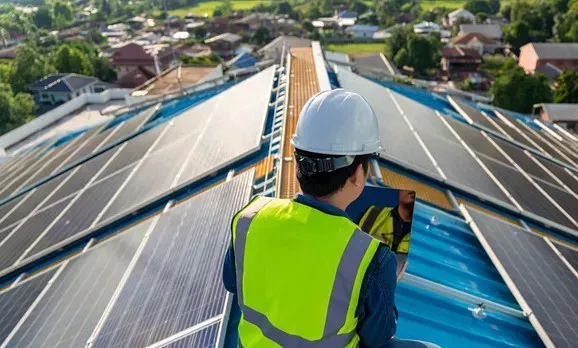Consumer-led integration and control: The rise of residential microgrids

In 1976, Los Alamos National Laboratory took delivery of the first Cray 1 supercomputer. Cray Research sold more than 80 of these at a cost of about $8mm each, or about $35 million in 2022 dollars. The Cray 1 performed 160 million floating point operations per second (MFLOPS), consumed 115,000 watts, had a total storage capacity of 303 megabytes (MB), and weighed 5.5 tons, including its freon cooling system. By comparison, the iPhone 13 sells for about $1,000. It fits in your pocket, has up to 512GB of storage, consumes 6.9 watts, and its A15 Bionic processor performs up to 249 billion floating point operations per second (GFLOPS). Apple sold more than 239 million iPhones in 2021 and over two billion iPhones since its introduction in 2007.
Existing smartphone capabilities form microgrid technology backbone
The breathtaking progression from Cray to iPhone is, on one level, an expression of Moore’s Law—the doubling of transistors on a microchip every two years or so. Equally significant is the array of sensors and communication modules manufactured at scale to meet iPhone (and other smartphone) demand, including:
- 12-megapixel photographic chip that also enables facial recognition
- Miniature microphones and speakers that enable voice interaction
- 5G cellular, GPS satellite, Bluetooth, and Wi-Fi communication modules
- Accelerometer, gyroscope, barometer, proximity, ambient light, and digital compass sensors
Both the computing power and the broad range of sensors and communication modules on display in the iPhone are prerequisites to consumer-led integration and control of their in-home “microgrid.” That is not to say that operating a residential microgrid demands massive computing capability—it does not. But enabling homeowners with no training or technical expertise to program and manage such a microgrid using verbal commands does.
From the perspective of the utility or Independent System Operator (ISO), the prospect of balancing a regional grid that has thousands—perhaps hundreds of thousands—of microgrids “on the edge” is daunting. Nonetheless, the opportunity for more granular load management (think house-specific demand response programs) is enticing, particularly given the potential significant load growth resulting from EV charging and the electrification of home appliances:
- Level 2 EV chargers can draw up to 80 amps at 240 volts. This would be by far the largest circuit in nearly all homes in the US. Even at 40 amps, the increased load would be equivalent to that of a double wall oven. It takes about 10 hours to charge a Tesla S from 20% to 100% on a 40-amp level 2 charger.
- As homeowners look to decarbonize and fossil fuels become less widely available, home heating, cooking, and hot water systems will shift from using natural gas, propane, or heating oil to electricity. This could triple a home’s peak electrical load, and that’s before considering if there is an EV in the garage.
To meet this challenge, utilities will need either to increase supply (generation, transmission, and distribution system capacity) or manage demand by applying technologies such as microgrids on the edge of the grid.
Residential large loads already equipped to communicate
With sensor and communication module costs driven down by smartphone-required scale manufacturing, many large household electrical loads are already fitted with cellular, Wi-Fi, or Bluetooth-enabled modules that allow them to communicate with the internet. Examples include:
- Central HVAC systems are typically the largest single electrical load in US homes, especially those with electric heat. The US EPA estimated that by the end of 2021, nearly 40% of residential HVAC systems were controlled by a smart thermostat.
- Popular EV Level 2 chargers, like JuiceBox and NeoCharge, are Wi-Fi enabled, and it is likely that all future models of EV chargers will have Wi-Fi and/or cellular network capability.
- Major home appliance manufacturers, such as LG and Samsung, offer Wi-Fi connectivity across a wide range of appliances, including refrigerators/freezers, washers/dryers, cooktops, ovens, microwaves, window-mounted air conditioners, and so on. Even smaller kitchen appliances are routinely fitted with Wi-Fi capability, including a microwave that responds to voice commands via a built-in Alexa smart speaker—cost: $75.
- Larger custom homes are frequently equipped with home automation systems that, at a minimum, allow for centralized control of built-in interior lighting devices and exterior landscape/security lighting.
Potential sources of household generation
So that sums up the usual residential loads. What about sources of generation? These may include:
- Charged EVs connected to their chargers. For example, a fully charged Tesla S is effectively a 100kWh battery on wheels
- Battery Energy Storage Systems (BESS), such as the Tesla Wall unit
- On-site solar panels
- Diesel, natural gas, or propane-fueled backup generators, which have become standard equipment in larger custom homes in cities, like Houston, that have suffered extended grid outages in recent years
All these sources could be monitored, managed, coordinated, and synchronized with utility grid-supplied power to achieve objectives specifically defined by the homeowner, such as:
- Maximize resilience to ensure that in the event of a grid outage, specific circuits/appliances are prioritized to receive backup power
- Minimize grid load, perhaps to comply with a utility or Retail Electricity Provider (REP) demand response program
- Maximize sale of excess on-site generation to utility
Our vision for how a home microgrid would work
Many residential electricity customers have individual apps on their smartphones to control their smart thermostat, their EV charger, and an appliance or two. It reminds us of a collection of remote controls piled on the sofa in front of the television. Our vision is simple: a single app that acts as the central brain controlling the ecosystem of home appliances that both consume and generate power in coordination with the broader electric grid—in other words, a true microgrid.
- Consolidate the apps that control individual household loads and sources of generation into a single app with an intuitive dashboard.
- Incorporate customized electricity pricing plans (such as “Time of Use”) and any load deferring arrangements (such as demand response programs) into the operating logic in the app.
- Enable smart-speaker voice control of loads and sources according to the homeowner’s preferences. For instance: “Alexa, minimize the cost of charging my EV tonight, ensuring I have a 50% charge by 6:30 in the morning.” A more complex example: “Alexa, until I say otherwise, use my EV battery to provide backup power to the refrigerator and primary bedroom air conditioner, but never let my EV battery go below 25%.”
This blog post was originally published here.


